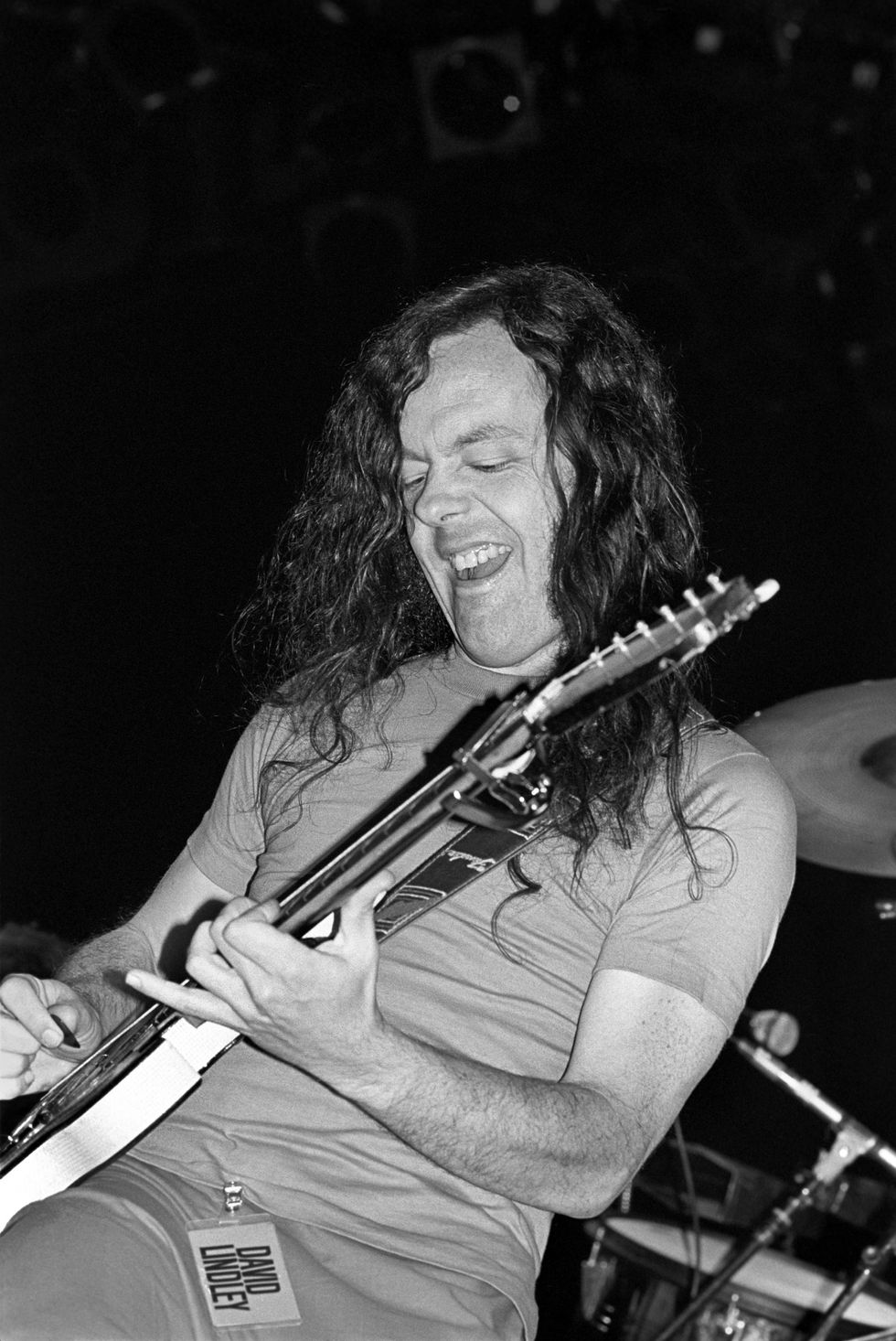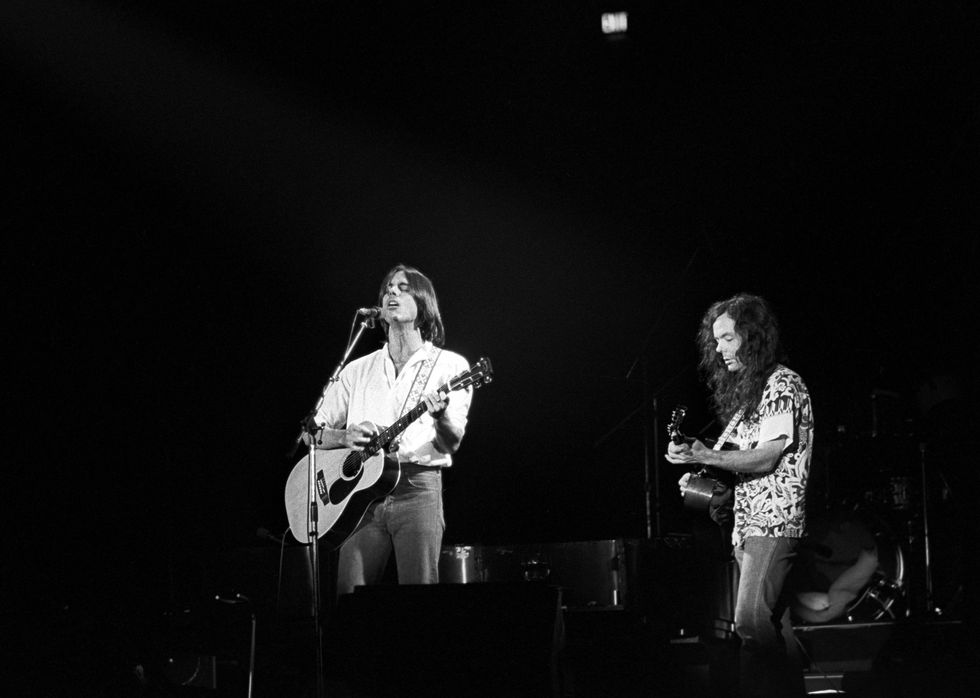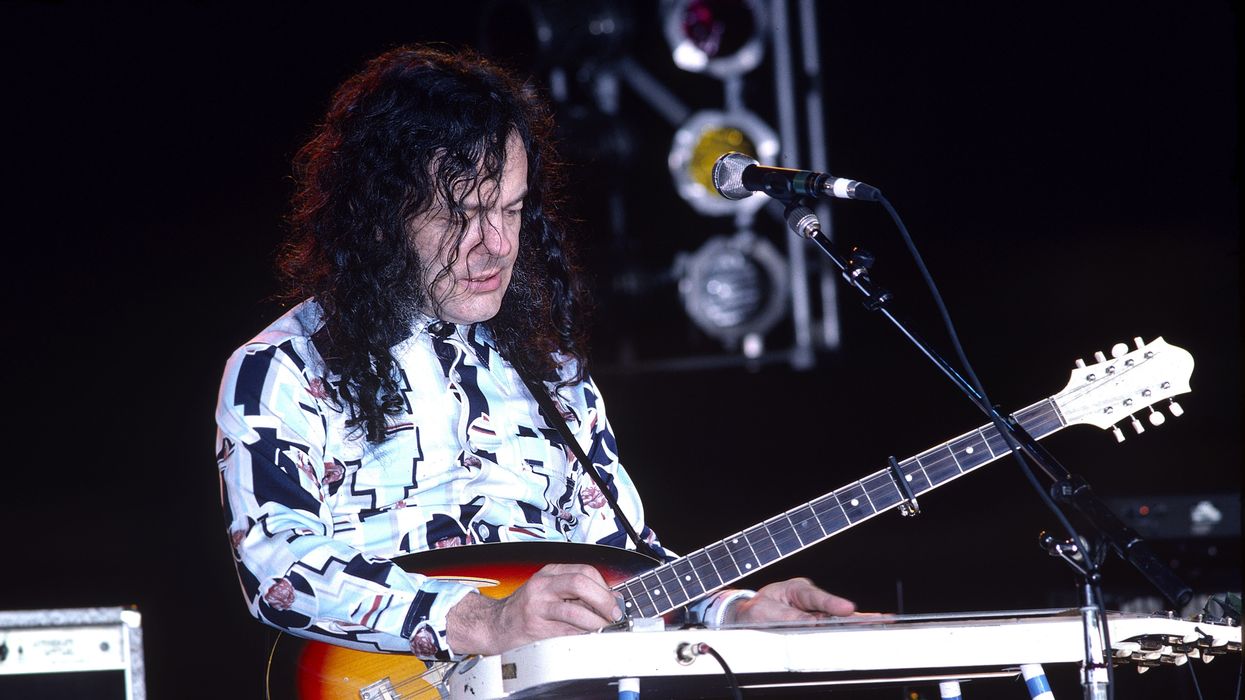People often ask me, “Who was the best musician you ever met?” or, “Who was your favorite interviewee?” I always say David Lindley and David Lindley. Across 47 years and some 1,000-plus interviews, with such fascinating subjects as Frank Zappa and George Harrison and master musicians the caliber of Stéphane Grappelli and James Jamerson, Lindley takes the cake.
Have you ever been too depressed to cry? That’s been my condition since hearing that Lindley died on the morning of March 3 due to complications with long Covid. I did nine articles on David and interviewed him several times more. In the grand scheme of things, it’s very rare for a writer and artist to become friends and have a relationship beyond the interview. But there was a connection from our first meeting, and I was lucky enough to spend quality, “off the clock” time with David.
I’ve been asked to share a few stories about Lindley … not to make it all about Me, but to illustrate what kind of person, as well as musician, he was.
In 1967, I saw the man in Kaleidoscope, arguably the first “world music” rock band, decades before the term was coined. They played an “Electric Band Session” as part of the Berkeley Folk Music Festival. I was not quite 14. Practically every member of the group was a multi-instrumentalist, and David even brought his huge Gibson harp guitar (an early-20th Century Style U) on the road. At one point they’d gotten themselves situated with their chosen instruments when, just before the downbeat, some fan hollered, “Louisiana Man!” They paused, looked at each, and then started exchanging instruments while the crowd laughed. They proceeded to peel off a terrific rendition of Doug Kershaw’s Cajun classic.
Decades later, I interviewed Ben Harper, who was a neighbor of the Lindleys growing up in Claremont, California. He’s about 15 years younger than I am, and when I told him I’d seen the band, we got into a “No way!” “Way!” exchange à la Wayne’s World.
I first interviewed Lindley in 1977, after a United Farm Workers benefit with Jackson Browne and Warren Zevon. Riding to the hotel with Lindley and Zevon, their back-and-forth had me laughing all the way, including a battle of the Long John Silvers: Robert Newton versus Wallace Beery.
Completing the interview a month later at his home, David allowed me into the “inner sanctum,” where instruments took nearly all floor and wall space—guitars, steels, banjos, mandolins, fiddles, viola de gamba, saz, tar, cümbüş, the Gibson harp guitar, and more. Regarding his approach to disparate instruments, he said, “You know how an ant can taste and hear and smell with one organ—this all-encompassing feeler? That’s more what it’s like … being an ant.”
Blurring lines between traditional and iconoclastic, he studied, investigated, incorporated, and became a prominent voice in styles spanning the globe, on more instruments than even he knew. He said, “I played all kinds of things which were ‘not played’ on guitar.” This included bowing an electric guitar. He laughed, “And it wasn’t Jimmy Page.”

David Lindley lays into a vintage Silvertone. Dan Forte recalls, “He was the first guy I saw in a major act playing Silvertone amp-in-case models or a Dan Armstrong London with two sliding pickups—extracting killer tones—leading me down a rabbit-hole hunt for Goyas and Zim-Gars.”
Photo by Ebet Roberts
In the process, he expanded the parameters of popular music, stylistically and instrumentally, to a degree that precious few can claim.
His inspiration for taking up lap steel was the late bluesman Freddie Roulette. But of influences on the instrument, he said, “I’m basically a sax player”— naming King Curtis, Junior Walker, and David Sanborn.
Obituaries lump him in with soft rock, which was true of much of his ’70s work. But the highlights of countless Jackson Browne concerts were Lindley’s incandescent lap-steel solos on “Doctor My Eyes” and “Running on Empty.” And his performances were also an indelible part of hits by Linda Ronstadt, Rod Stewart, Zevon, Dolly Parton, and many more.
When it finally came time for a solo album, 1981’s El Rayo-X defied and exceeded all expectations. It was mature, fully realized, and original; eclectic but cohesive. Rather than present a Whitman’s sampler of various styles, he said, “I wanted to have a coherent theme to the whole thing.
“You know how an ant can taste and hear and smell with one organ—this all-encompassing feeler? That’s more what it’s like … being an ant.”—David Lindley
His associates were eager to sing his praises, and I was able to interview several. Booker T. Jones said, “He’s the one who makes the band go,” while Ry Cooder declared, “He has the sensitivity that allows him to grasp what the hell is going on.”
Graham Nash described a session with Lindley on fiddle: “I said, ‘I’d like you to stand on the street corner and play like an old bum.’ And he said, ‘Boy, that’s real easy for me.’”
Ronstadt offered, “He just instinctively gravitates towards something that is extremely high-quality and has integrity in whatever art form he’s contemplating—which is a lovely thing to have.”

Although Lindley supports Jackson Browne on round-neck guitar here, the highlights of countless Browne concerts were Lindley’s incandescent lap-steel solos on “Doctor My Eyes” and “Running on Empty.”
Photo by Ebet Roberts
And Browne stated, “I can’t even call it ‘my music’ when I think about David, because he’s such an integral part of it."
The band David put together, also named El Rayo-X, was without question one of the top five live bands I ever saw. And I saw Jimi Hendrix twice! Mr. Dave had me open for them in 1981, when my surf combo Cowabunga had only done three gigs. But I got to actually play with David in ’98, as part of the Festival d'été de Québec City’s “guitar summit,” featuring Martin Simpson, Bob Brozman, percussionist Wally Ingram, and Lindley on acoustic Hawaiian Weissenborn slide. During a mini-rehearsal, I’m guessing he could sense that I was nervous. (Wouldn’t you be?) But he put me at ease, and wanted to give me a chunk of the spotlight. I asked him if he still did “Brother John,” the Wild Tchoupitoulas song. I had a second line take on “Limbo Rock,” so we stitched them together. Somewhere during my solo, I quoted War’s “Low Rider,” and Lindley was on it in a millisecond.
Things That Lindley Fans Might Not Know About Him
• Correlating his musical aptitude and high school track career, he said, “I could run hurdles the first time—I knew what I was doing. So, they put me in the 120 low hurdles.”
• Also, during high school, he played flamenco in a guitar duo.
• The bane of Lindley’s existence was that loud knock from housekeeping—despite threatening signs he affixed to hotel doors. As good as he was with voices, his impersonation of a mad dog just inside the door was so convincing, the next sound was that of the maid running for dear life.
• He was a great cartoonist, illustrating his solo CDs with comical self-portraits.
• David once mentioned that Peter Lewis of Moby Grape was his cousin. I said, “Isn’t he Loretta Young’s son?” “Yep.” “So, Loretta Young is your aunt?” It’s true: Lindley was part of the same gene pool as the epitome of Hollywood glamor.
• At a time when female producers were extremely rare, he asked Ronstadt to helm his fourth solo album, Very Greasy.
• He was an expert marksman and archer.
• He and guitarist/producer Henry Kaiser traveled to Madagascar to record the acclaimed A World Out of Time albums with indigenous musicians, resulting in considerable income for the Malagasy players and citizens.
The Zone
I’ve always been fascinated with the so-called “zone” musicians sometimes achieve, like a basketball player with a hot hand, when you play something you didn’t know you could. It doesn’t require virtuosity, but the chances for someone with Lindley’s talent surely improves the odds. He described the sort of out-of-body experience. “I fail a lot. When that happens, that’s when you have to fall back on all the mechanical stuff and technique,” he told me in 2006. But being in the zone, he said, was like watching himself from three feet away.
“The bane of Lindley’s existence was that loud knock from housekeeping. His impersonation of a mad dog just inside the door was so convincing, the next sound was that of the maid running for dear life.”
I’ve thought about what influence, if any, David had on me. Not as a guitarist, really, because I can’t play like him; no one can. But he was the first guy I saw in a major act playing Silvertone amp-in-case models or a Dan Armstrong London with two sliding pickups— extracting killer tones—leading me down a rabbit-hole hunt for Goyas and Zim-Gars. He even gave me my pen- and stage-name, Teisco Del Rey. Then there was his clothes. Need I say more?
He was a serious musician not taking himself too seriously. He didn’t hide his wacky sense of humor in order to make music of the highest order. That’s the dichotomy. He wrote songs like “Sport Utility Suck,” “Cat Food Sandwiches,” and “When a Guy Gets Boobs,” and told hilarious stories onstage. He led audiences in singalongs to Frizz Fuller’s “Tiki Torches at Twilight.” So, you’d see this leprechaun in garish polyester, talking about Krispy Kreme donuts, and then he’d play something beautiful like his “Quarter of a Man” or something biting like "Revenge Will Come” [for every child kept down].
He gave me permission to display all sides of my personality, and you have that permission too. We have him to thank for that and so much more.































![Rig Rundown: AFI [2025]](https://www.premierguitar.com/media-library/youtube.jpg?id=62064741&width=1245&height=700&quality=70&coordinates=0%2C0%2C0%2C0)




















 Zach loves his Sovtek Mig 60 head, which he plays through a cab he built himself at a pipe-organ shop in Denver. Every glue joint is lined with thin leather for maximum air tightness, and it’s stocked with Celestion G12M Greenback speakers.
Zach loves his Sovtek Mig 60 head, which he plays through a cab he built himself at a pipe-organ shop in Denver. Every glue joint is lined with thin leather for maximum air tightness, and it’s stocked with Celestion G12M Greenback speakers.






